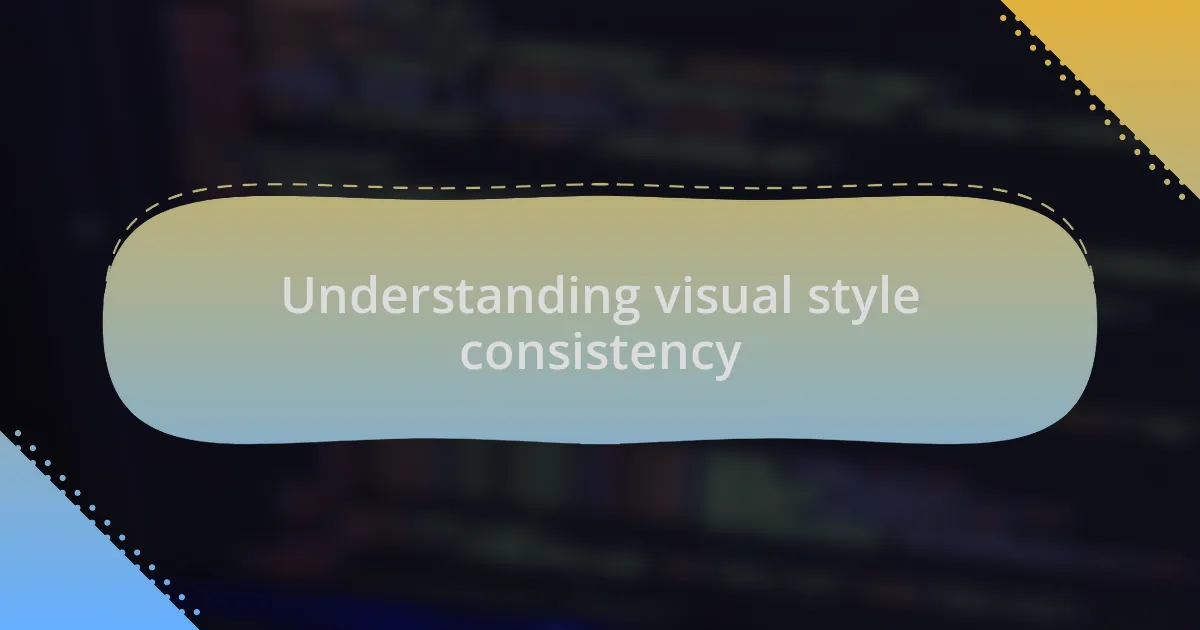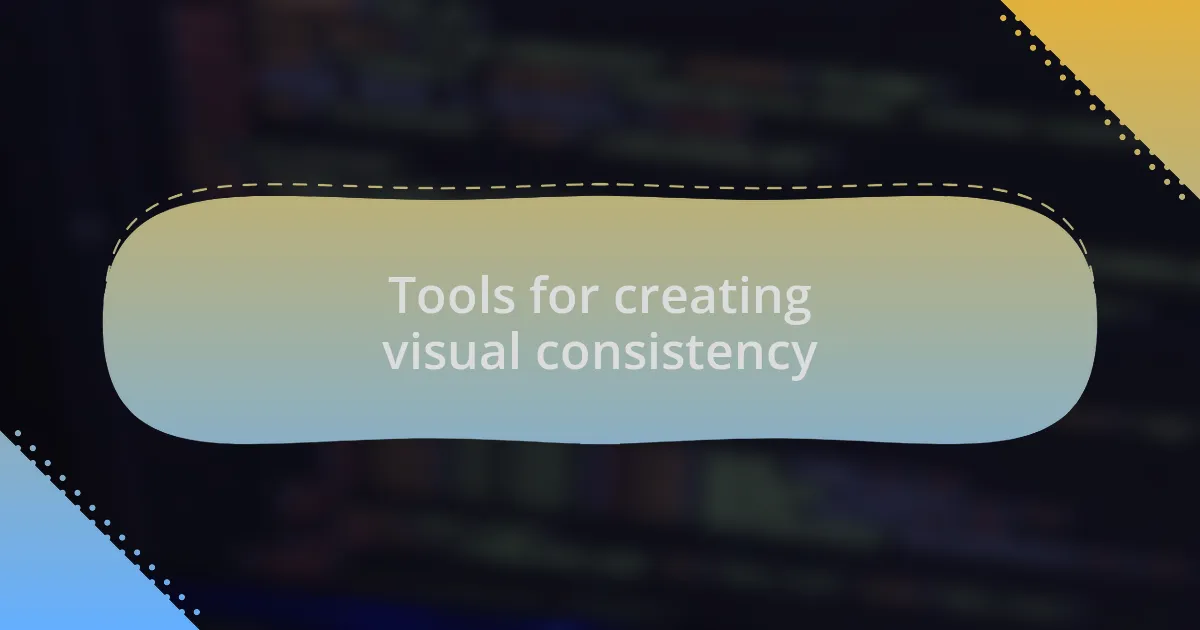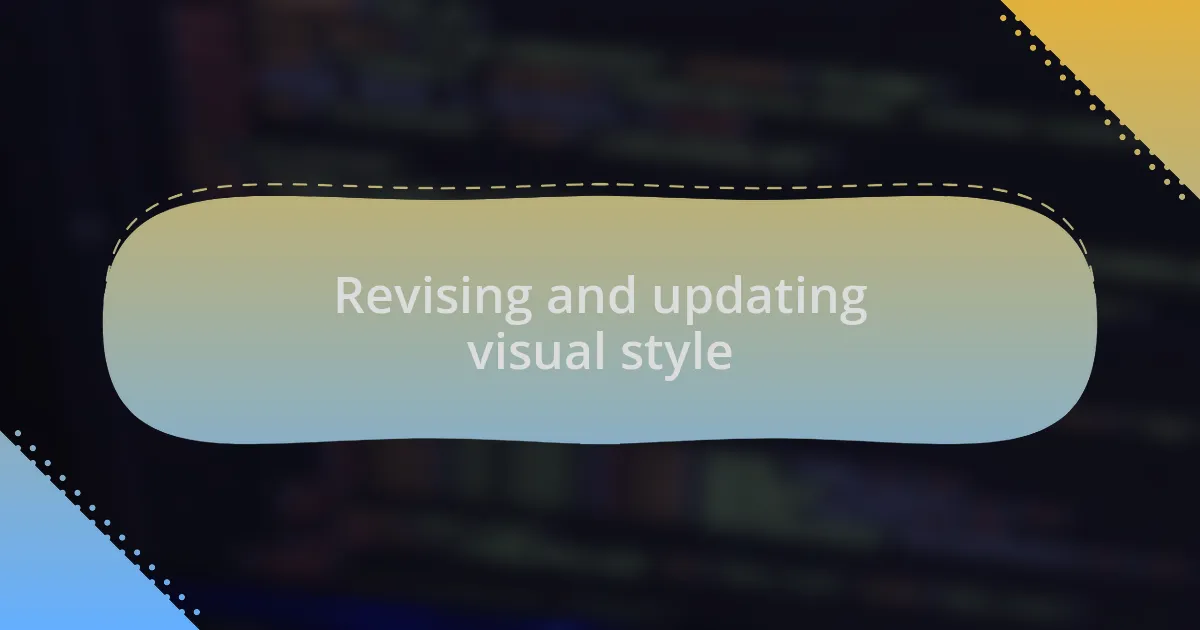Key takeaways:
- Visual style consistency enhances user experience, builds trust, and improves content credibility.
- Utilizing design tools like Bootstrap and Figma aids in maintaining a unified visual style across platforms.
- Establishing clear style guidelines and tone of voice in tutorials boosts reader engagement and content navigation.
- Regularly revising and updating visual elements in response to feedback and trends improves the overall user experience.

Understanding visual style consistency
Visual style consistency is vital for creating a cohesive user experience on any website. Think about the last time you visited a site that seemed to jumble different colors and fonts. Did it feel chaotic? That’s often the result of inconsistency, which can confuse visitors and undermine the credibility of the content.
In my experience, a consistent visual style acts like a guiding thread that weaves through all elements of a website. For instance, when I revamped my own programming tutorial site, I chose a specific color palette and font family that reflected the site’s personality. It was satisfying to see how these choices not only made the content visually appealing but also encouraged more engagement from readers.
Have you ever noticed how brands like Apple or Google maintain a seamless visual identity across platforms? It’s intentional. They understand that a unified style helps build trust and recognition. Every time I see their sleek typography or clean design, I’m reminded that consistency isn’t just about aesthetics; it’s a fundamental principle of effective communication in the digital landscape.

Tools for creating visual consistency
When it comes to tools for achieving visual consistency, I find that design systems are incredibly valuable. For example, I used a design framework called Bootstrap while working on my programming tutorials site. It provided pre-defined components and styles, which made maintaining consistency across various pages a breeze. Have you ever tried using a framework like this? It can save you countless hours of tweaking.
Another tool I leverage is Figma, which has become my go-to for designing layout and style. Figma allows me to create reusable components and define a color scheme that I can apply consistently. This way, I know if I choose a button color or a header font in one place, it will look identical everywhere else. It simplifies collaboration too—when I work with others, we can all see and adhere to the same visual guidelines. How often do you collaborate on design projects?
Finally, I can’t stress enough the power of style guides. During a recent project, I crafted a detailed style guide that outlined everything from typography to spacing. This acted as my north star, ensuring that no matter who contributed to the content, the overall look stayed unified. Have you ever created a style guide? I guarantee it streamlines the design process and fortifies visual consistency across your site.

Developing a personal visual style
Developing a personal visual style begins with understanding your preferences and aesthetic values. For instance, I spent hours curating inspiration from various websites and design platforms. In doing so, I realized that I’m drawn to minimalistic designs that prioritize readability, which led to a deeper exploration of simple layouts and clean lines. Have you ever considered what styles resonate with you?
As I fine-tuned my visual style, I found it essential to experiment with color palettes that evoke specific emotions. I recall the excitement of choosing a vibrant blue for buttons on my site; it not only aligned with my personal brand but also felt inviting to visitors. This connection between color and emotion has made a lasting impact on my approach. How do the colors you choose communicate your unique message?
Another element I value deeply in developing a visual style is consistency in imagery. I remember a time when I mixed various illustration styles, and it created a disjointed feel across the site. This experience taught me to select a specific style of graphics that reflected the content of my tutorials. Now, every image feels like a part of a cohesive story. Have you explored how the right imagery can enhance your site’s overall look?

Implementing style guidelines in tutorials
When implementing style guidelines in my tutorials, I’ve found that establishing a clear structure is paramount. I remember creating a tutorial that varied in formatting between sections. It ended up being visually jarring and hard to follow. Now, I always stick to consistent heading sizes, font choices, and spacing, making the content easier for readers to navigate. Isn’t it satisfying when everything flows smoothly?
In addition to structure, I focus on the tone of voice used throughout my tutorials. Early on, I experimented with a formal writing style, which I learned felt disconnected with my audience. Shifting towards a more conversational tone transformed my engagement levels significantly. I often ask myself, “How would I explain this to a friend?” This question helps me maintain relatability, making complex concepts feel accessible. Have you thought about how your writing style affects your readers?
Another crucial aspect is the use of icons and bullet points. I vividly recall a tutorial where I relied solely on long paragraphs, and I lost my audience halfway through. To solve this, I began incorporating icons to illustrate key points and using bullet points for clarity. This not only makes the content visually appealing but also helps highlight important takeaways. How do you think visual elements can convey your message more effectively?

Revising and updating visual style
Revising the visual style of my website is an ongoing journey. I remember the day I decided to reassess my color palette after receiving feedback from readers that the previous scheme felt too harsh. By experimenting with softer tones, I discovered that the overall atmosphere of my site shifted from overwhelming to inviting, creating a space where visitors felt more comfortable learning.
Whenever I update my visual elements, I try to keep a close eye on trends that resonate with my audience. I vividly recall updating the button styles on my site after noticing a rise in minimalistic designs that draw the eye. I asked myself, “What changes could enhance usability while still feeling fresh?” This not only made my call-to-action buttons stand out but also aligned my site with current design preferences, facilitating a more engaging user experience.
I find it essential to regularly review the visual consistency across my website. I recently completed an audit of my tutorials and discovered some old images that didn’t match my current style. It felt tedious at first, but I realized this was a great opportunity to enhance the learning experience by ensuring that every visual element added value. Have you ever considered how visual inconsistencies can impact your readers’ perception of your content? Taking the time to revise and update can truly make a difference.